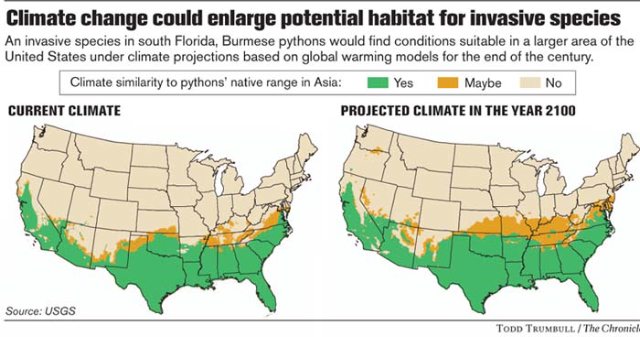San Francisco Pythons by 2020
Posted by: Loren Coleman on May 10th, 2008

Some studies indicate that due to projected climate change, pythons will be a common feature of the “alien wildlife” in San Francisco by the year 2020.
About Loren Coleman
Loren Coleman is one of the world’s leading cryptozoologists, some say “the” leading living cryptozoologist. Certainly, he is acknowledged as the current living American researcher and writer who has most popularized cryptozoology in the late 20th and early 21st centuries.
Starting his fieldwork and investigations in 1960, after traveling and trekking extensively in pursuit of cryptozoological mysteries, Coleman began writing to share his experiences in 1969. An honorary member of Ivan T. Sanderson’s Society for the Investigation of the Unexplained in the 1970s, Coleman has been bestowed with similar honorary memberships of the North Idaho College Cryptozoology Club in 1983, and in subsequent years, that of the British Columbia Scientific Cryptozoology Club, CryptoSafari International, and other international organizations. He was also a Life Member and Benefactor of the International Society of Cryptozoology (now-defunct).
Loren Coleman’s daily blog, as a member of the Cryptomundo Team, served as an ongoing avenue of communication for the ever-growing body of cryptozoo news from 2005 through 2013. He returned as an infrequent contributor beginning Halloween week of 2015.
Coleman is the founder in 2003, and current director of the International Cryptozoology Museum in Portland, Maine.










Sooo, wait… I’m a little lost here. San Fran has the climate already, and someone is saying that it will take 12 years for the snake to get there? Sorry, there wasn’t much said in the article, and the map only showed that the green fills in little corners of states (not much changed). Is this the python that is destroying Hawaii’s ecosystem?
Folks in San Francisco shouldn’t worry too much though…
‘Cause the world is gonna end on dec. 21, 2012 anyway!!
*evil grin* 😉
I’m more worried about “Killer” bees.
You understand that this is just a scare tatic? How are pythons going to get here? There are not enough boerd python owners too create an invasion.
They’re already there. Who doesn’t believe that amateur herpetologists and enthusiasts haven’t discovered their pet pythons missing on plenty of occasions. The bounty in slow witted family pets, racoons and other suitable foods are adequate and the climate, on those occasions where it does get chilly, is never sever enough to kill a fill sized constrictor who’d wait it out beneatht he leaves and detritus that border almost every suburban street in the Bay Area. I personally know of one incident in which a friend who was snake enthusiast actually found a 9 foot boa in San Carlos ten years ago.
cool , they’re edible right? Can’t wait.
CamperGuy, yes, and they taste like chicken.
PMC 🙂
Just an update…I’m in the green zone in central Oklahoma. No pythons on the menu yet. If they ever get here maybe we can have Python hunting season to go along with the rattlesnake round-ups.
Climate does not equal habitat.
Unless these rampaging pythons are going to grow massive on a diet of rodents, there’s not much to worry about in the Southwest. Rattlers will easily out-compete them.
I once heard that Florida, as a subtropical environment, may be regarded as the “capital” of introduced species in the western hemisphere (both plants and animals). So, if there are shifts related to bioclimatic zones, it would be much more than the Asian pythons that would have expanded habitat. However, these “negatively charismatic” species would understandably be of the highest concern to people.
It must be noted that, although these are regarded as “alien” or “invasive” species, they are really human-assisted introductions. In addition to these, the genuinely native species of the tropical and subtropical environments would also likely show expanded range, in the case of these climate change / global warming scenarios (whether natural, anthropogenic or a combination of both). The unfortunate reality is that the biota do not respect man-made administrative boundaries, and would respond to climatic (and therefore habitat) shifts, regardless of whether we decide that they are supposed to be there or not. This brings back the question of wildlife and natural resource management schemes and their ideas of what is considered to be a “normal” part of the ecosystem. While these species are regarded as “alien” or “invasive” does that have any basis in a practical reality or is it simply an administrative / management conceptualization?
While humanity tends to pride itself with the idea of being the highest species in terms of being modifier, controller and adapter of nature, the fact remains that this power is neither absolute nor even especially dominant; the will of the Earth’s natural environment – defined by its dynamic complex of linkages, synergies and interactions among the processes, components and sub-systems of the atmosphere, hydrosphere, lithosphere and biosphere – will always prevail.